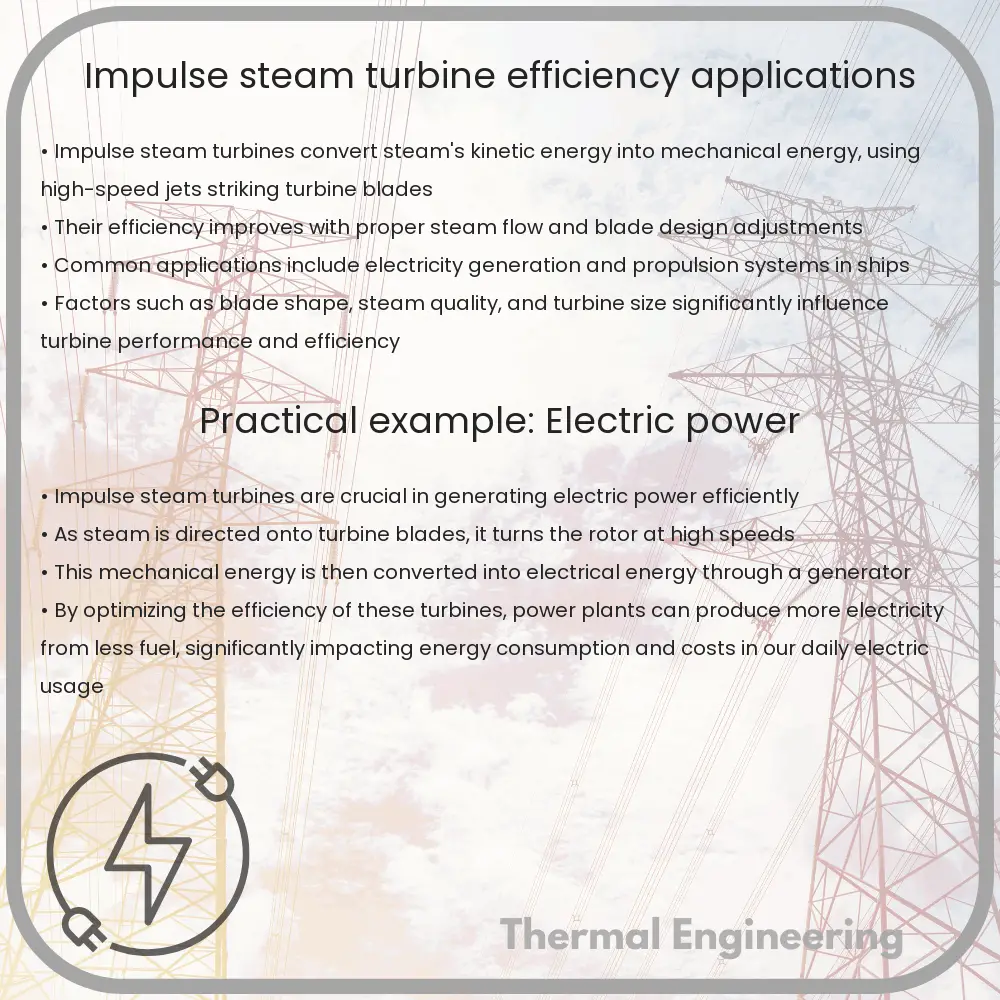Learn about impulse steam turbines, their operation, efficiency, and diverse applications in industries such as power generation and aerospace.

Understanding the Impulse Steam Turbine: Efficiency and Applications
An impulse steam turbine is a type of steam turbine where the rotor gets its energy from the kinetic energy of the steam at high velocity. Unlike reaction turbines that use both the energy from the pressure and velocity of the steam, impulse turbines solely depend on the kinetic energy transformed from the steam’s pressure. This fundamental principle behind the impulse steam turbine plays a significant role in its construction, efficiency, and applications.
Principle of Operation
In an impulse steam turbine, steam is initially pressurized in a boiler and then directed onto turbine blades through a nozzle. As steam passes through these nozzles, it expands, speeds up to a high velocity, and jets out against the turbine blades. The interaction of steam with the turbine blades converts the kinetic energy of the steam to mechanical energy, thereby rotating the turbine shaft. This conversion underscored by the conservation of momentum, fundamentally describes the operating principle of an impulse steam turbine.
Mathematically, the change in momentum of the steam generates a force on the turbine blades as illustrated by the equation:
F = Δ(mv)
where F represents the force exerted on the blades, m is the mass of the steam, and v is the velocity of the steam. The steam’s velocity transformation through the nozzles and the resultant force produced is crucial for achieving the turbine’s rotational movement.
Efficiency of Impulse Steam Turbines
The efficiency of an impulse steam turbine mainly depends on how effectively it can convert the steam’s kinetic energy into mechanical energy. Factors that affect its efficiency include the design of the turbine, such as the shape and arrangement of the nozzles and blades, steam conditions (pressure and temperature), and the load conditions under which the turbine operates. Losses in efficiency mainly arise from:
- Nozzle efficiency: This refers to the effective conversion of thermal energy into kinetic energy in the nozzles. Inadequate design can lead to significant energy losses.
- Blade friction and windage: As the steam interacts with the turbine blades, friction between the blade surfaces and the steam leads to energy losses.
- Profile losses: Caused by the aerodynamic design of the blades which can lead to turbulence and vortices reducing the turbine’s efficiency.
- Other mechanical and thermodynamic losses: Such as leakage in the seals, bearing friction, and entropy production during steam expansion.
Overall, improvements in blade geometry and nozzle design, along with optimal control of steam conditions, help in minimizing these losses thereby maximizing the turbine’s efficiency. The efficiency of impulse steam turbines typically ranges, but it is generally less than that of reaction turbines given the conservation restrictions primarily at higher pressure operations.
Applications of Impulse Steam Turbines
Impulse steam turbines are widely used across various sectors due to their robust design and ability to handle high-pressure gradients efficiently. Their applications include:
- Power Generation: Most commonly used in electricity generation from nuclear, coal, natural gas, and biomass power plants.
- Marine Propulsion: Used in marine vessels for propulsion systems where high-speed rotation is essential.
- Industrial Processes: Applied in industries for driving centrifugal pumps, fans, compressors, and other machinery.
- Aerospace: Utilized in jet engines where high-speed exhaust is necessary for propulsion.
In summary, impulse steam turbines are a pivotal engineering tool in many modern applications. Their ability to convert steam’s kinetic energy into mechanical work efficiently, despite inherent energy losses, plays a crucial role in the realms of power generation and beyond. Continuous advancements in turbine technology focus on enhancing their design and operational efficiency to meet the increasing energy demands and environmental standards.